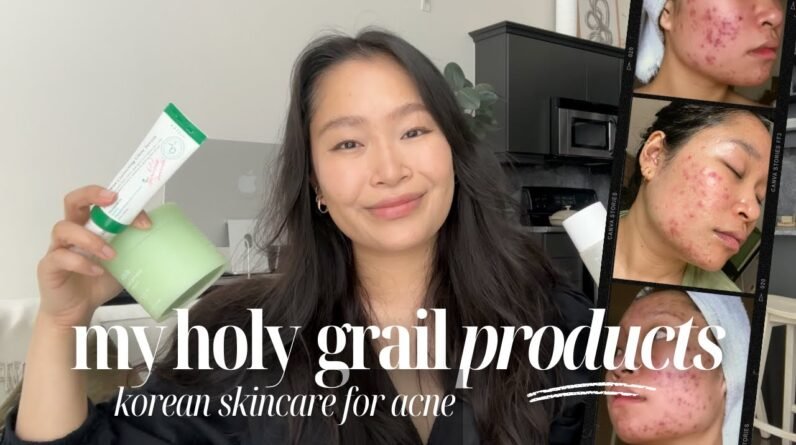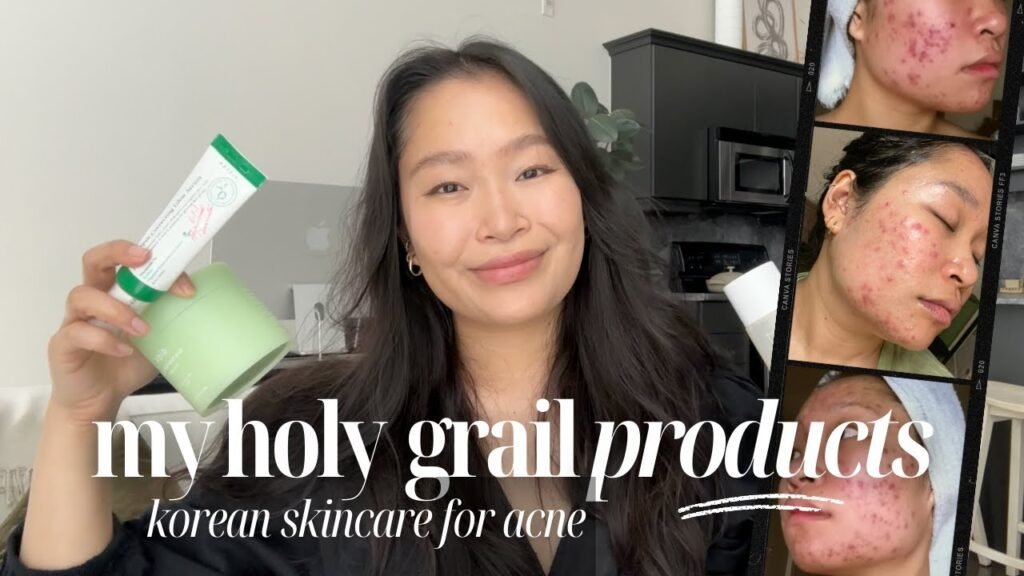
Hey there! I’ve got an exciting video to share with you today. It’s all about my updated holy grail skincare products for healing active breakouts, adult acne, and scarring. If you’ve been struggling with hormonal acne or dealing with texture issues and dark spots, then this video is definitely for you.
In the video, I go through my entire skincare routine step by step, starting with double cleansing and moving on to toners, spot pads, serums, moisturizers, and more. I also share some helpful tips, like changing your pillowcases frequently and avoiding patting your face dry with towels. These products have been a game-changer for me, and I’m so excited to share them with you. So, let’s dive right in and get those breakouts under control!
Understanding the Nature of Acne
Acne is a common skin condition that affects both teenagers and adults. It is characterized by the presence of pimples, blackheads, whiteheads, and sometimes inflammation. Acne can be classified into two main types: active breakouts and adult acne.
Active breakouts refer to the regular appearance of new pimples and blemishes on the skin. This type of acne is often associated with hormonal changes, such as during puberty or menstruation. It can be frustrating and may cause emotional distress, especially when it affects someone’s self-esteem.
On the other hand, adult acne refers to acne that occurs in adults, usually after the age of 25. This type of acne is often caused by hormonal fluctuations, stress, diet, and genetics. Unlike active breakouts, adult acne is more persistent and may require specialized treatment to manage.
Hormonal Fluctuations and Their Influence on Acne
Hormonal fluctuations play a significant role in the development and persistence of acne. When hormone levels fluctuate, it can lead to an overproduction of sebum, an oily substance that clogs pores and contributes to the formation of acne.
During puberty, the body produces higher levels of androgens, a type of hormone that stimulates the sebaceous glands to produce more sebum. This increase in sebum production can lead to acne breakouts. Similarly, hormonal changes during the menstrual cycle can also trigger acne in women.
In addition to puberty and menstruation, hormonal imbalances can also occur in adults. Conditions such as polycystic ovary syndrome (PCOS) can disrupt hormone levels and lead to persistent acne. It is essential to address hormonal imbalances to effectively manage and treat acne.
The Effects of Stopping Birth Control on Skin Health
Many women use birth control methods to manage their hormone levels and prevent pregnancy. Some forms of birth control, such as combination birth control pills, contain hormones that can help regulate sebum production and reduce acne.
However, when a person stops using birth control, their hormone levels may fluctuate, which can trigger acne breakouts. This is because the body is adjusting to the natural hormonal balance without the aid of synthetic hormones from birth control.
In some cases, stopping birth control can lead to a resurgence of acne, even if the person had clear skin while using it. It is important to be aware of this possibility and consult with a healthcare professional or dermatologist for guidance on managing acne when stopping birth control.
My Personal Acne Journey
I personally have experienced the struggles of dealing with acne. After finding a skincare routine that helped improve my skin, I enjoyed a period of clear and healthy skin. However, after stopping birth control, my acne resurfaced, and I had to navigate finding a new birth control method to keep my acne under control.
The recurrence of acne took a toll on me emotionally and psychologically. It is common for acne to impact an individual’s self-esteem and confidence. Dealing with breakouts and inflammation on a regular basis can be challenging and can lead to feelings of frustration and self-consciousness.

The Importance of Professional Help
For individuals dealing with severe acne, it is crucial to seek professional help from a doctor or dermatologist. These healthcare professionals can provide guidance and prescribe medication or treatments to manage and control acne effectively.
Consulting a doctor or dermatologist is especially important for those dealing with hormonal acne. These healthcare professionals can help regulate hormone levels through various treatment options, such as hormonal birth control or prescription medication.
Additionally, seeking professional help can help individuals distinguish between myths and truths about skincare. There is a lot of misinformation and misconceptions surrounding acne and skincare, and consulting with a professional can provide accurate and personalized advice.
Double Cleansing
Double cleansing is a skincare technique that involves using two different cleansers in succession to ensure a thorough cleansing of the skin. The first step typically involves using an oil-based cleanser to remove makeup, sunscreen, and excess oil from the skin. This is followed by a water-based cleanser to remove any remaining impurities.
Double cleansing is particularly beneficial for those with acne-prone skin. The oil-based cleanser helps to dissolve excess sebum, while the water-based cleanser further cleanses the skin and removes any remaining impurities. This technique can help prevent clogged pores and reduce the risk of acne breakouts.
When choosing products for double cleansing, it is essential to consider your skin type and concerns. Look for gentle, non-comedogenic cleansers that are suitable for acne-prone skin. There are many recommended products available, such as Banila Co Clean It Zero Cleansing Balm, which is popular for its effectiveness in removing makeup and impurities.
Toners and Spot Pads
Toners play a crucial role in a skincare routine, especially for acne-prone skin. They help balance the skin’s pH level, remove traces of dirt and impurities, and prepare the skin for the next steps of the routine. Toners containing ingredients like AHAs (alpha hydroxy acids) and BHAs (beta hydroxy acids) can exfoliate the skin gently and unclog the pores, reducing the chances of acne formation.
Spot pads, on the other hand, are targeted treatments for acne breakouts. These pads typically contain ingredients that soothe inflammation, reduce redness, and promote healing. They can be applied directly to affected areas to deliver active ingredients and provide relief.
When choosing toners and spot pads for treating acne, it is essential to consider the specific needs of your skin. Look for products that are alcohol-free, non-irritating, and suitable for sensitive skin. Some recommended toners and spot pads include AHA/BHA toners like Nambusan Toner and spot pads like Olive Young Care Plus Scar Cover Spot Patch.
Serums and Spot Treatments
Serums are concentrated formulations that contain active ingredients to target specific skincare concerns. When it comes to treating acne, serums can play a significant role in healing active breakouts and reducing the appearance of acne scars and dark spots.
Serums containing ingredients like niacinamide, vitamin C, and hyaluronic acid can help regulate sebum production, fade hyperpigmentation, and promote collagen production for smoother skin. These serums can be applied after toning and before moisturizing, allowing the active ingredients to penetrate deeply into the skin.
Spot treatments, on the other hand, are products designed to be applied directly onto active breakouts. These treatments often contain ingredients like salicylic acid or benzoyl peroxide, which can help unclog pores, reduce inflammation, and kill bacteria.
When choosing serums and spot treatments, it is important to consider your specific skincare concerns and the ingredients that work best for your skin type. Some recommended serums and spot treatments for acne-prone skin include The Ordinary Niacinamide and Alpha Arbutin serums and La Roche Posay Alpha Klair Duo spot treatment.
Moisturizers and Sunscreens
Moisturizing and sun protection are crucial aspects of any skincare routine, especially when dealing with acne. Contrary to popular belief, acne-prone skin also requires hydration and protection from the sun’s harmful rays.
Moisturizers help to hydrate the skin and maintain its moisture barrier. They can also provide skin-soothing benefits and help regulate sebum production. It is important to choose lightweight, non-comedogenic moisturizers that won’t clog the pores or exacerbate acne.
Sunscreens protect the skin from the damaging effects of the sun, including sunburn, premature aging, and an increased risk of skin cancer. Look for sunscreens labeled as “broad-spectrum” and with an SPF of 30 or higher. Non-comedogenic formulas are also recommended to prevent clogged pores.
When choosing moisturizers and sunscreens for acne-prone skin, consider products that are formulated for sensitive skin and labeled as suitable for acne-prone or oily skin types. Some recommended moisturizers and sunscreens for acne-prone skin include Caudalie Vino Perfect moisturizer and AXIS-Y Dark Spot Correcting Glow Serum.
Extra Acne Care: Masks and Nose Strips
In addition to the regular skincare routine, incorporating masks and nose strips can provide extra care for acne-prone skin.
Face masks are a popular way to target specific skincare concerns, including acne. Masks containing ingredients like clay, tea tree oil, or salicylic acid can help absorb excess oil, unclog pores, and soothe inflammation. They can be used once or twice a week to provide a deep cleanse and address specific acne-related issues.
Nose strips are another useful tool for acne-prone skin, specifically targeting blackheads. These strips, when applied to the nose area, adhere to the skin and help pull out dirt, oil, and blackheads from the pores. They provide a quick and effective way to remove blackheads and improve the appearance of the nose area.
When choosing masks and nose strips for acne treatment, look for products that are specifically formulated for acne-prone or oily skin. Some recommended face masks and nose strips for acne treatment include The Face Shop Real Nature Tea Tree Sheet Mask and Holika Holika Pig Nose Clear Blackhead 3-Step Kit.
Lifestyle Changes for Better Skin Health
In addition to a well-rounded skincare routine, making certain lifestyle changes can contribute to better skin health and help manage acne.
Cultivating a routine of changing pillowcases regularly is essential. Pillowcases can accumulate dirt, oil, and bacteria, which can transfer onto the skin at night and contribute to acne breakouts. Changing pillowcases at least once a week can help minimize the risk of bacterial buildup and reduce the likelihood of acne flare-ups.
Avoiding towel drying for acne-prone skin is also recommended. Rubbing the skin with a towel after cleansing or showering can cause irritation and may spread bacteria. Instead, gently pat the skin dry with a clean towel or let it air dry to prevent unnecessary friction and potential acne aggravation.
Incorporating gua sha into a skincare routine can also be beneficial for improved circulation and lymphatic drainage. Gua sha is a traditional Chinese practice that involves using a tool to gently scrape the skin, promoting blood flow and reducing inflammation. This technique can help enhance overall skin health and aid in acne management.
Conclusion: Towards a Healthy Skincare Routine
Maintaining a consistent skincare routine is crucial for managing and improving acne-prone skin. By understanding the nature of acne, including its different types and causes, and seeking professional help when necessary, it is possible to develop an effective skincare routine.
It is important to find a balance between using products that target specific skin concerns and allowing the skin to heal naturally. Emphasizing self-worth and beauty beyond physical appearance is also essential. Remember that skincare is not just about achieving clear skin; it is about taking care of oneself and prioritizing overall well-being.
By following the steps outlined in this article, incorporating double cleansing, toners and spot pads, serums and spot treatments, moisturizers and sunscreens, masks and nose strips, and making necessary lifestyle changes, individuals with acne-prone skin can work towards healthier, clearer skin.
Take the time to research and find suitable products for your skin’s unique needs, and don’t hesitate to consult with a healthcare professional or dermatologist for personalized advice. With dedication and patience, it is possible to achieve and maintain healthy, acne-free skin.






